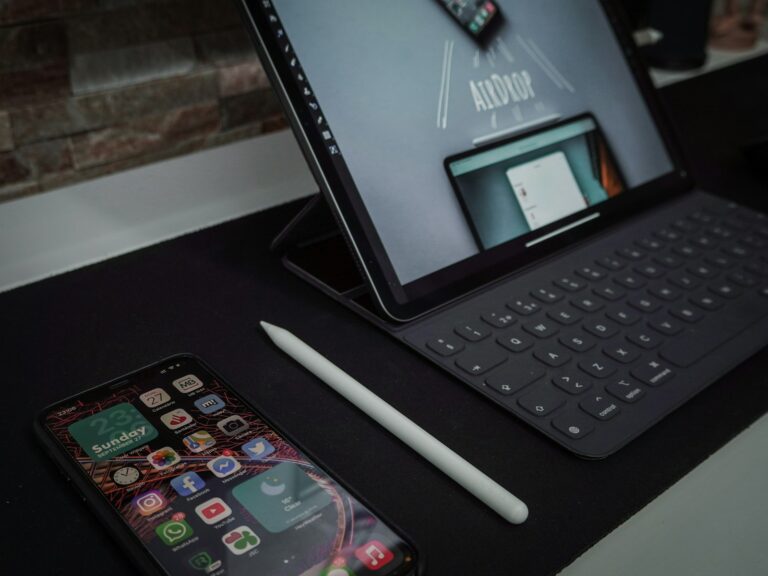
Creating PDF files on your iPhone is easier than you might think, and it’s a valuable skill for organizing digital documents. Whether you need to save important information, share professional materials, or preserve website content, the iPhone offers built-in tools to help. You can create a PDF on your iPhone by simply opening any content, tapping the Share icon, and selecting the Print option, which gives you the ability to save as PDF without actually printing anything.
The process works for almost any type of content – webpages, photos, emails, and documents. This helpful feature doesn’t require any additional apps and comes standard with iOS. Many users don’t realize this capability exists right at their fingertips, making document management much simpler on the go.
1. Convert a Webpage or Document to PDF
- Open Safari (or another app with share options).
- Tap the Share button (square with an arrow).
- Scroll down and select Print.
- On the print preview, use a two‑finger pinch‑out gesture (zoom in).
- The preview turns into a PDF.
- Tap the Share button again → choose Save to Files or send via Mail, Messages, etc.
2. Turn Photos or Screenshots into a PDF
- Open the Photos app.
- Select one or more images.
- Tap the Share button → choose Save to Files.
- In the Files app, open the folder where you saved them.
- Tap and hold the images → select Create PDF.
3. Scan Documents into PDF
- Open the Files app (or Notes app).
- Tap the three dots (…) → choose Scan Documents.
- Use the camera to scan pages.
- Adjust edges if needed → tap Keep Scan.
- Save → the scan is automatically stored as a PDF.
4. Save Email or Attachments as PDF
- Open the Mail app and view the email.
- Tap the Reply/Forward button → choose Print.
- Use the pinch‑out gesture on the preview.
- Save or share the PDF as needed.
5. Manage and Share PDFs
- Use the Files app to organize PDFs into folders.
- Store them in iCloud Drive for syncing across devices.
- Share via AirDrop, Mail, or Messages directly from Files.
✅ Tip: For frequent use, create a dedicated “PDFs” folder in the Files app to keep everything organized
Key Takeaways
- Creating PDFs on iPhone requires no additional apps as the feature is built into iOS through the Share and Print functions.
- PDFs can be made from virtually any content including webpages, photos, notes, and documents using the Share icon method.
- After creating a PDF, you can mark it up or annotate it before saving it to your preferred location.
Understanding PDFs on the iPhone
iPhones have built-in capabilities that make working with PDFs simple and efficient. These digital documents maintain their formatting across all devices, making them ideal for sharing important information.
What Is a PDF?
PDF stands for Portable Document Format, a file type developed by Adobe that preserves document formatting regardless of the device or software used to view it. Unlike other document formats, PDFs maintain their exact appearance across platforms.
PDFs can contain text, images, hyperlinks, form fields, and even multimedia elements. They’re essentially digital versions of printed documents that anyone can view without needing the original software used to create them.
On iPhones, PDFs are handled by the built-in Files app and can be viewed through Safari or the Books app. The format is especially useful because it:
- Keeps formatting consistent across all devices
- Cannot be easily edited without special software
- Maintains high-quality images and graphics
- Works on virtually any computing platform
Benefits of Using PDF Files
PDFs offer several advantages for iPhone users over other file formats. The primary benefit is universal compatibility – anyone can open and view PDF files exactly as intended without special software.
PDF content is also secure. You can password-protect sensitive documents or add restrictions to prevent unauthorized copying or printing of information.
The format is space-efficient compared to image files of documents, allowing you to store more PDFs on your iPhone without consuming excessive storage space.
For professionals, PDFs provide a professional appearance for resumes, contracts, and business documents. They’re perfect for:
- Official documentation that requires consistent formatting
- Forms that need to be filled out digitally
- Brochures and presentations with complex layouts
- E-books and digital publications
iPhone users can easily create PDFs without third-party apps, making it convenient to convert website content, emails, or photos into this versatile format.
Tools Required for Creating PDFs
Creating PDFs on an iPhone requires different tools depending on your specific needs. The right tool can make the process simple and efficient while offering features that match your document requirements.
Built-In iOS Features
iPhones come with several built-in features that allow users to create PDFs without additional apps. The most common method uses the Print option in the Share menu. When viewing any content, users can tap the Share icon, select Print, then pinch outward on the preview to save it as a PDF.
The Files app offers another convenient option. Users can long-press on a document and select Create PDF from the Quick Actions menu to instantly convert compatible files.
The Notes app also supports PDF creation. After creating a document or scanning papers, users can export the content as a PDF by using the Share button and selecting the appropriate option.
These native tools handle basic PDF creation needs without requiring extra storage space or purchases.
Third-Party PDF Editors
For more advanced PDF features, third-party editors provide comprehensive solutions. Foxit PDF Editor for iOS offers a user-friendly interface for creating blank PDFs or converting existing documents.
PDFElement delivers professional-grade editing capabilities including:
- Text and image editing
- Form filling and creation
- Document annotation
- Electronic signatures
- Password protection
Adobe Acrobat Reader, while primarily a PDF viewer, includes creation features in its premium version. It integrates smoothly with other Adobe products and cloud services.
These apps typically offer free basic versions with premium upgrades for advanced features like batch processing, OCR (Optical Character Recognition), and unlimited storage.
Online PDF Services
Web-based PDF tools provide alternatives when dedicated apps aren’t preferred. Many services work directly through iPhone browsers without requiring downloads.
Popular online options include Smallpdf, PDF24, and ILovePDF. These platforms allow users to convert various file formats to PDF directly from their iPhone.
The advantages of online services include:
- No app installation required
- Less storage usage
- Access to features not available in free apps
- Cross-platform compatibility
Most online PDF services offer free tiers with limited monthly conversions. Premium subscriptions typically remove these restrictions and add advanced editing features.
Users should consider privacy implications when uploading sensitive documents to online services and check the provider’s data protection policies.
Creating a PDF from Documents and Images
Converting documents and images to PDF format on iPhone is simple with built-in tools. Apple offers multiple ways to create PDFs without needing third-party apps.
Using the Photos App
The Photos app on iPhone provides a straightforward method to convert images to PDF files. To begin, open the Photos app and select the image you want to convert. Tap the share button (square with an upward arrow) at the bottom left of the screen.
Scroll through the sharing options and select “Print.” This will open the Printer Options screen. Now comes the hidden PDF feature – use a pinch-out gesture (spread two fingers apart) on the preview image at the bottom of the screen.
This gesture creates a PDF preview of the image. A new share sheet appears, allowing users to save or share the newly created PDF. The file can be saved to Files, Books, or shared via email, messaging apps, or AirDrop.
Scanning Documents with the Camera
The iPhone’s Notes app includes a powerful document scanner for creating professional-looking PDF files. Open Notes and create a new note or open an existing one. Tap the camera icon above the keyboard and select “Scan Documents.”
Position the document within the frame. The camera automatically detects document edges and captures it when ready. Users can adjust the corners for precise cropping if needed.
After scanning, users can add more pages or tap “Save” to complete the scan. The document appears in the note with options to mark it up or share it. To create a PDF, tap the document in the note, then the share button, and select “Create PDF” or “Share as PDF” from the options.
This feature works excellently for scanning various documents including receipts, forms, and handwritten notes.
Converting Text Files and Web Pages
Safari makes it easy to convert web pages to PDF format. While viewing a webpage, tap the share button at the bottom of the screen. Scroll through the options and select “Print.”
When the print preview appears, use the same pinch-out gesture on the preview image. This creates a PDF version of the webpage that can be saved or shared.
For text files such as Word documents or emails, the process is similar. Open the document, tap the share button, and select “Print.” Then use the pinch gesture on the preview to create a PDF of just about anything.
This method works across most apps that support printing, including Mail, Pages, and third-party document apps. The resulting PDFs maintain formatting and are perfect for sharing or archiving important information.
Editing PDF Files on the iPhone
iPhones offer several ways to modify PDF documents without needing a computer. You can add notes, combine documents, and make text changes directly from your device using various tools and apps.
Adding Annotations
The built-in Markup tool on iPhone lets you add annotations to any PDF file. To access this feature, open your PDF in the Files app and tap the Markup button. This tool provides options to highlight text, underline important sections, and add comments.
You can also draw directly on PDF documents using your finger or Apple Pencil (on compatible devices). This makes it easy to sign documents, circle important information, or add handwritten notes.
Text annotations can be added by tapping the “+” button in the Markup toolbar. These notes appear as small icons that expand when tapped, keeping your document clean while still containing your thoughts.
Merging and Splitting PDF Pages
Combining multiple PDFs or removing specific pages is possible directly on your iPhone. The Files app allows basic PDF management, letting you select pages and reorder them.
For more complex tasks, specialized apps offer better control. These apps let users:
- Combine multiple PDF files into one document
- Extract specific pages from larger documents
- Reorder pages through simple drag-and-drop interfaces
- Remove unwanted pages without affecting the rest of the document
Most PDF management apps provide preview functionality so you can see changes before finalizing them. This helps prevent mistakes when reorganizing important documents.
Using a PDF Editor App
For comprehensive editing capabilities, dedicated PDF editor apps like Adobe Acrobat or PDFElement offer the most features. These apps allow direct editing of text, images, and other PDF content.
With a PDF editor, users can:
- Change existing text within documents
- Add new text blocks matching original formatting
- Insert, resize, or replace images
- Add clickable links and form fields
- Apply watermarks or headers/footers
Many PDF editors offer cloud synchronization, enabling work to continue across devices. Adobe Acrobat provides a browser-based interface that prompts users to sign in with Google, Apple, or Adobe accounts.
Free versions of these apps typically offer basic editing features, while premium subscriptions unlock advanced functionality like OCR (Optical Character Recognition) for scanning and editing paper documents.
Sharing and Managing PDF Files
Once you’ve created a PDF on your iPhone, you’ll need effective ways to share and organize these files. Apple offers several built-in options that make PDF management straightforward and efficient.
Using iCloud and Other Cloud Services
The Files app on iPhone provides a central location for saving and managing PDFs across different cloud services. Users can store PDFs in iCloud Drive for access across all Apple devices.
To save a PDF to iCloud:
- Open the PDF file
- Tap the share icon
- Select “Save to Files”
- Choose iCloud Drive or another cloud location
- Tap “Save”
Other cloud services like Google Drive, Dropbox, and OneDrive integrate directly with the Files app. This allows for easy organization using folders and tags to keep PDFs sorted by project, date, or importance.
Cloud storage offers backup protection and frees up device storage. Users can also set up automatic syncing to ensure the latest version is always available across devices.
Sending PDFs via Email or Messaging Apps
Sharing PDFs from an iPhone is simple through the universal share sheet. To share a PDF, users need to:
- Open the PDF in any viewer
- Tap the share icon (square with up arrow)
- Select the desired sharing method
Email remains a popular option for sending PDFs in professional settings. The Mail app allows attaching multiple PDFs and supports large files.
For quicker sharing, messaging apps like iMessage, WhatsApp, and Slack provide convenient options. These platforms maintain PDF formatting and allow recipients to preview documents without downloading.
AirDrop offers the fastest method for sharing with nearby Apple users, transferring PDFs instantly without size limitations or quality reduction.
Printing PDF Files Directly from iPhone
The iPhone’s AirPrint feature enables wireless printing of PDFs to compatible printers. To print a PDF:
- Open the PDF file
- Tap the share icon
- Select “Print”
- Choose an AirPrint-enabled printer
- Adjust settings like number of copies or page range
- Tap “Print”
Many printer manufacturers offer dedicated apps for extended functionality beyond AirPrint’s capabilities. These apps may provide options for print quality adjustment, paper selection, and ink level monitoring.
For those without an AirPrint printer, services like Google Cloud Print or printer-specific apps can bridge the gap. Some office supply stores also offer remote printing services where users email PDFs and pick up prints later.
Productivity Tips for PDF File Management
Managing PDF files effectively can enhance workflow and save time. The right organization system, shortcuts, and integration methods make PDF handling much smoother on iPhone devices.
Organizing PDF Files on the iPhone
Creating a logical folder structure is the foundation of good PDF management. Users can create folders within the Files app by tapping the folder icon and selecting “New Folder.” Naming conventions help tremendously – consider using prefixes like “INVOICE-” or “CONTRACT-” for quick identification.
Color-coding is another powerful organization tool. The iPhone Files app allows users to mark folders with different colors for visual categorization.
Tags provide another layer of organization. Users can add multiple tags to a single PDF, making it findable through different search criteria. To add tags, long-press a file, select “Tags,” and choose or create appropriate tags.
Setting up automatic sorting rules with Shortcuts app can help maintain order. Create an automation that moves newly created PDFs to designated folders based on their content or creation method.
Shortcuts for Frequent PDF Creations
The iPhone’s built-in PDF creation capabilities can be enhanced with custom shortcuts. Users can create a shortcut that converts images to PDFs with a single tap using the Share and Print method.
For business cards or receipts, create a dedicated shortcut that:
- Takes a photo
- Enhances image quality
- Converts to PDF
- Names the file with date and location
- Saves to a specific folder
Voice commands through Siri can streamline the process further. Set up phrases like “Create invoice PDF” to trigger your custom shortcuts.
Third-party apps like PDF Expert offer batch processing capabilities, allowing users to convert multiple files to PDF format simultaneously.
Integrating PDF Files with Business Workflows
Cloud storage integration ensures PDFs are accessible across all devices. Services like iCloud, Dropbox, and Google Drive sync automatically, making PDFs available on computers and tablets instantly.
Email automation can be set up to forward PDFs to relevant team members. Use the Mail app’s rules to automatically categorize incoming PDF attachments and send notifications.
Digital signature tools eliminate printing needs. Apps like PDF App: Convert, Create, Sign allow users to add legally binding signatures to documents directly on their iPhone.
Workflow apps like Shortcuts can create multi-step automations. For example, a “Client Onboarding” shortcut could:
- Create a contract PDF from a template
- Add client information
- Request digital signature
- Save to client folder
- Send confirmation email
These integrations reduce manual steps and ensure consistency across business processes.
Frequently Asked Questions
Creating PDFs on iPhone can be simple with the right approach. Many users have common questions about converting different types of content and using various apps for PDF creation.
What are the steps to convert a photo into a PDF on iPhone?
Converting photos to PDF format on iPhone is straightforward. Users can select the photo in their Photos app and tap the share icon.
In the share menu, users should scroll down and select the Print option. After the preview appears, they can use a pinch-out gesture on the preview to convert it to PDF.
The resulting PDF can then be saved to Files or shared with others directly.
How can one create a PDF from multiple images on iPhone?
To combine multiple images into a single PDF, users can utilize the Files app. They should open the app and navigate to the location where they want to save the PDF.
Tapping the three dots in the upper corner will reveal a menu where they can select the document scanner. Users can scan multiple pages one after another.
After completing all scans, they can tap “Save” to create a multi-page PDF document from the images.
What is the process for making a PDF from Notes app on iPhone?
Creating a PDF from Notes is simple. Users should open the note they wish to convert and tap the share icon in the upper right corner.
In the share sheet, they need to select the Export option and then choose PDF as the format. The system will convert the note content to PDF format.
Once converted, users can save it to Files or share it through various apps including email or messaging services.
How can you generate a PDF file using the iPhone camera?
The iPhone camera can be used to create PDFs through the Files app. Users need to open Files and tap the three dots in the upper corner of the screen.
Selecting the document scanner option activates the camera. They should position the document within the frame and wait for the automatic capture.
The app will detect edges, correct perspective, and enhance readability automatically. Multiple pages can be added before saving the final PDF document.
Is there a method to create a PDF on an iPhone from documents within Google Docs?
Yes, Google Docs content can be converted to PDF on iPhone. Users should open the document in the Google Docs app and tap the three-dot menu icon.
From the menu, they can select “Share & export” and then choose “Save as PDF.” The document will be converted to PDF format.
After conversion, users can save the PDF to their preferred location or share it with others directly from the app.
Can you create a fillable PDF form using an iPhone, and if so, how?
Creating fillable PDF forms directly on iPhone has limitations, but third-party apps offer solutions. Apps like Foxit PDF provide form creation features.
Users can import existing PDFs and add form fields like text boxes, checkboxes, and dropdown menus. These apps typically offer intuitive interfaces for positioning and customizing form elements.
For complex forms, users might find it easier to create the basic structure on a computer and then make minor edits or fill them out on iPhone.





